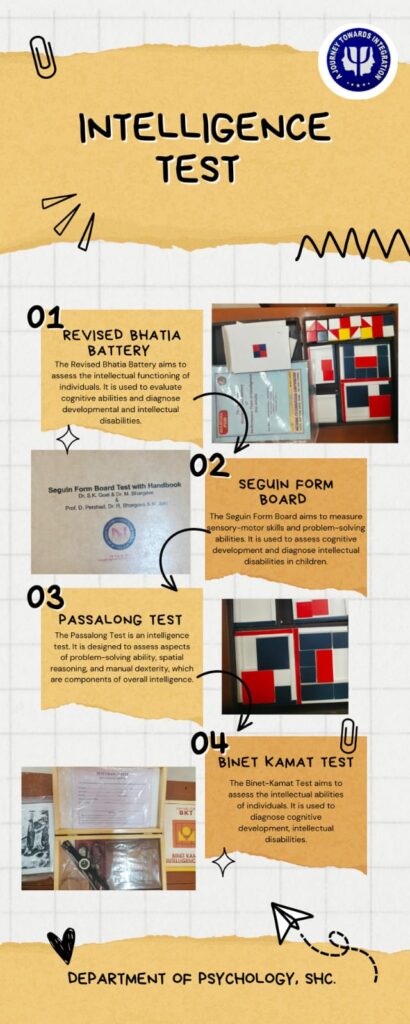EXPERIMENTAL PSYCHOLOGY
Experimental psychology is a branch of psychology that focuses on conducting systematic and controlled experiments to study human behavior and cognition.
Overview
Experimental psychology aims to gather empirical evidence and explore cause-andeffect relationships between variables. Experimental psychologists utilize various research methods, including laboratory experiments, surveys, and observations, to investigate topics such as perception, memory, learning, motivation, and social behavior.
Pavlov’s Dog
This experimental psychology experiment used scientific methods to develop a theory about how learning and association occur in animals. The same concepts were subsequently used in the study of humans, wherein psychology-based ideas about learning were developed. Pavlov’s use of the empirical evidence was foundational to the study’s success.
QUESTIONNAIRE LIST
- THEMATIC APPERCEPTION TEST
- 16 PF QUESTIONNAIRE
- MARRIAGE ATTITUDE SCALE
- SMART PHONE ADDICTION
- FAMILY RELATIONSHIP INVENTORY
- ANXIETY DEPRESSION STRESS SCALE
- DECISION MAKING STYLE SCALE
- ENGLISH ACHIEVEMENT TEST
- MULTIFACTOR INTEREST QUESTIONNAIRE
- DRAW MAN TEST
- ORGANIZATIONAL EFFECTIVE SCALE
- WORK MOTIVATION QUESTIONNAIRE
- HIGH SCHOOL PERSONALITY QUESTIONNAIRE
- SELF ACCEPTANCE INVENTORY
- ACADEMIC ANXIETY SCALE
- GENERAL INTELLIGENCE FOR COLLEGE STUDENTS
- CASE STUDY BLANK
- GESSELL’S DRAWING FOR INTELLIGENCE
- PERSONAL STRESS SOURCE INVENTORY
- FAMILY SCALE
- PARENT CHILD RELATIONSHIP SCALE
- YOUTH PROBLEM INVENTORY
- MENTAL HEALTH BATTERY
- STANDARD STRESS
- VOCATIONAL INTEREST RECORD
- CHILDREN PICTORIAL MEASURES OF SOCIAL COGNITIVE ABILITY
- DISTINCTIVE APTITUDE TEST BATTERY
- COMPREHENSIVE INTEREST TEST
- EYSENCK PERSONALITY QUESTIONARY
- SUICIDAL IDEATION SCALE
- LOCUS OF CONTROL
- TEST FOR ANXIETY
- PRIMARY CARE NETWORK SCALE
- STUDY HABITS INVENTORY
- STYLE OF LEARNING AND THINKING
- STATE TRAIT ANXIETY TEST
- TEACHER ADJUSTMENT INVENTORY
- JOB INVOLVEMENT SCALE
- OCCUPATIONAL STRESS INDEX
- FAMILY ENVIRONMENTAL SCALE
- BEHAVIORAL ORIENTATION SCALE
- MANAGERIAL ATTITUDE TEST OF BATTERY
- TEACHERS EFFECTIVENESS SCALE
- QUALITY OF WORK LIFE SCALE
- MEASUREMENT OF LEVELS OF ASPIRATION
- MARITAL ADJUSTMENT SCALE
- 5 PERSONALITY INVENTORY
- EMOTIONAL STABILITY TEST FOR CHILDREN
- ADJUSTMENT INVENTORY FOR COLLEGE STUDENTS
- EMOTIONAL INTELLIGENCE INVENTORY
- SENTENCE COMPLETION TEST
- BURNOUT INVENTORY
- EXAMINATION ANXIETY SCALE
- HAPPINESS SCALE
- ACHIEVEMENT MOTIVATION SCALE
- HERMAN RORSCHACH PSYCHODIAGNOSTIC SCALE
- ATTITUDE SCALE
- PSYCHOLOGICAL WELL BEING SCALE
- EYSENCK’S PERSONALITY INVENTORY
- EMOTIONAL MATURITY SCALE
- MOVEMENT IMAGERY QUESTIONNAIRE
- GUIDANCE NEED INVENTORY
- TEACHING APTITUDE TEST BATTERY
- MOTIVATION ANALYSIS TEST
- INTEREST ADDICTION SCALE
- DAVID’S BATTERY OF DIFFERENTIAL ABILITY
- GENERAL CLASSROOM ACHIEVEMENT TEST FOR 6 & 7
- CAREER PREFERENCE RECORD
- VINELAND SOCIAL MATURITY SCALE – INDIAN ADOPTION
- SELF ESTEEM SCALE
- TEACHER’S APTITUDE INVENTORY
- HAPPINESS SCALE
- QUALITY OF LIFE SCALE
CODE OF CONDUCT FOR PSYCHOLOGICAL LABORATORY
- Students are expected to maintain discipline while working in the lab.
- Punctuality – Be punctual to the class and in the completion of practical work and submission of records.
- Regularity – Be regular. As far as possible do not miss class. Bring the required stationery and observation and record books to class along with your calculator.
- Neatness – Hand in neat, covered records.
- Be Attentive – Be attentive to what goes on in the class and follow the instructions and procedure carefully.
- Understand and Communicate – While conducting the experiment or test on your subject, make sure you understand the instructions and communicate them clearly. Do not give unnecessary information.
- Respect – Show respect to not only the batch lecturer but also to examiners and fellow classmates.
- Honesty – Be honest in your work. Do not manipulate your results.
- Handle with care – Handle all apparatus with care.
- Helpful – Be helpful to your fellow batch mates who may need some extra help in completing the allotted work.
- The lab can be accessed as per the provisions in the time table.
- Students should not move around during the laboratory sessions from their assigned tables.
- No student will be allowed to enter or access the instrument/tests without the prior permission of the lab in charge.
- After the lab work has been done, students are supposed to rearrange the lab
- In the case of any damaged occurred (tests, apparatus, furniture’s) the concern student must pay for damage cost.
- If the student who has cause the damage is unidentified the concern as a group needs to pay for the damage.
Safety Protocol
- Utilise equipment/instruments just for their intended use, and handle them with extreme caution.
- Avoid placing or setting up equipment right up against the table’s edge.
- When using the electrical device, kindly be cautious and after using an electrical device, make sure that you have turn it off.
- Don’t turn on any equipment before the instructor has had a chance to assess it.
- Avoid touching any live wires or circuits on the instrument.
- Do not alter or move any equipment that is in use without the user’s permission.
- Avoid conducting any unauthorised or unethical experiments.
Equipment Details





